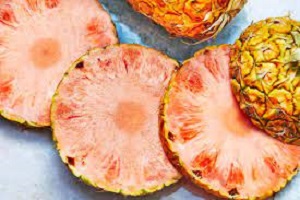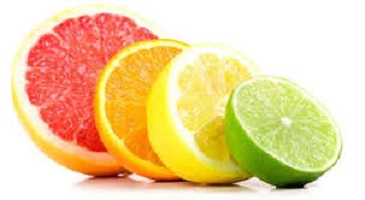What Is a Pink Pineapple? Taste | Is It Healthy?
What Is a Pink Pineapple? Taste | Is It Healthy?

Have you ever seen a pink-fleshed pineapple? If you haven’t already, allow me to introduce you to the wonderful world of pink pineapples.
This one-of-a-kind fruit, also known as the “Jewel of the Jungle,” has acquired appeal due to its eye-catching hue and peculiar flavor.
Del Monte’s years of research and genetic engineering have transformed a common tropical fruit into an intriguing gourmet experience.
Pink pineapples are a genetically modified organism (GMO) created by changing the fruit’s lycopene and beta-carotene levels.
Lycopene is a red pigment found in tomatoes, watermelon, and papaya that is noted for its antioxidant effects.
As the fruit matures, the lycopene content falls and the yellow component beta-carotene increases, resulting in the typical yellow color. However, lycopene is preserved in pink pineapples, giving the fruit its lovely pink color.
What Makes a Pink Pineapple Pink?
Pink pineapples were created by altering a tiny enzyme that affects the color of the fruit’s flesh. An enzyme is a substance that causes a certain biological reaction.
In this case, typical yellow pineapples contain many enzymes that convert the pink component lycopene into the yellow pigment beta carotene.
Scientists suppressed that specific enzyme to make the pineapple pink, preventing it from becoming yellow.
The term beta carotene may seem familiar. Carrots and other colorful vegetables contain this yellow and orange pigment.
Lycopene is the pigment that causes tomatoes to turn red and watermelons to turn pink. Pigments are similar to plant-based food colors. The darker the color, the higher the concentration.
Because these pigments are exclusively active in the meat of the fruit, they do not affect the pink pineapples’ outside skin.
So, if you see photographs of pineapples with pink skin on the outside instead of brown or tan, you’re looking at a terrible Photoshop job.
How to Do Pink Pineapples Taste?

Pink pineapples taste similar to yellow pineapples but are somewhat sweeter, and juicier, and feature hints of pink Starburst (AKA the superior Starburst flavor), according to our taste testers.
Pink glow pineapples, according to Fresh Del Monte, offer “a delicious and unique taste, with notes of candy pineapple aromatics.”
According to Fresh Del Monte, pink pineapples contain lycopene, the same pigment that turns watermelons pink and strawberries red, and have a sweeter, less acidic taste than ordinary pineapple.
What is the distinction between pink and yellow pineapple?
The pink pineapple fruit is a GMO, or “genetically modified organism.”
All pineapples contain lycopene before they reach maturity. As a conventional pineapple ripens, the red pigment lycopene decreases, and the yellow pigment beta-carotene increases.
This causes the flesh of the pineapple to turn yellow.
Where can you find pink pineapple?
These pineapples are considered a rare treat, and they are not as common as conventional pineapples.
Pink pineapples can be found practically anywhere globally, but only on a single farm in Costa Rica’s South-Central region with the correct soil and temperature.
Del Monte is the only business that produces this type in small quantities, so you may not be able to purchase it elsewhere other than grocery stores that offer it.
Nutritional profile of pink pineapple
It contains lycopene, a natural pigment that lends the red color to several fruits and vegetables.
Because it contains lycopene, this pineapple is pink. Lycopene has been linked to a variety of health advantages, including its antioxidant properties.
A fantastic source of vitamin C. Vitamin C aids in the maintenance of a healthy immune system.
Are Pink Pineapples Safe to Eat? What are Pink Pineapple’s Health Benefits?
Pink pineapple health benefits: Pink pineapples, like regular pineapples, are high in vitamin C and manganese. They also include trace levels of thiamin, vitamin B6, and folate.
Pink pineapples are particularly high in fiber and contain enzymes that may aid digestion. Pineapples also contain bromelain, a group of anti-inflammatory enzymes.
Immune system booster
Pink pineapples are high in vitamin C, which is essential for a healthy immune system.
Researchers discovered that vitamin C helps maintain the body’s health by stimulating the production of white blood cells. White blood cells are essential in the fight against infections and viruses.
The fruit also contains a lot of phytochemicals including flavonoids and anthocyanin. These molecules can help protect the body from free radical damage, which can harm cells, proteins, and DNA.
Pink pineapple contains bromelain, which has anti-inflammatory benefits. They aid in the reduction of inflammation in the body, which is a factor in many chronic diseases such as heart disease, type 2 diabetes, and arthritis.
- Digestion Aids
Pink pineapples are high in fiber, which is beneficial to your digestive system.
Fibre makes feces more bulky and regular, preventing constipation and other digestive disorders.
Bromelain also aids in protein digestion and lowers intestinal irritation. This assists the body in breaking down meals and prevents bloating and gas.
Pink pineapples also stimulate the production of stomach acid and enzymes, which aid in the breakdown of food and make it easier to digest.
- Promotes cardiovascular and blood vessel health
Pink pineapples are abundant in potassium, which helps manage blood pressure and reduces the chance of developing high blood pressure.
The fruit is also low in calories, which is beneficial for maintaining a healthy weight and minimizing the chance of being overweight, which is a major cause of cardiovascular disease.
Pink pineapples are also high in fiber, which can lower cholesterol and lessen the risk of heart disease.
The fruit also contains trace amounts of folate, which aids in the reduction of homocysteine levels. Homocysteine is an amino acid that has been linked to cardiovascular disease.
- Clear vision
Pink pineapples are high in vitamin C, which helps protect the eyes from free radical damage. Vitamin C also protects the eyes from the harmful effects of UV radiation.
It also contains a lot of beta-carotene, which the body converts into vitamin A, which is essential for good vision.
Vitamin A is also vital for maintaining the retina’s health and preventing age-related eye disorders such as macular degeneration and cataracts.
Pink pineapples also include key elements such as zinc and manganese, which are required to maintain eye health and prevent vision loss.
- Promotes faster wound healing
Pink pineapple has a lot of bromelain. This enzyme can aid in the reduction of edema and inflammation in a wound, hence hastening the healing process.
Bromelain also helps wound healing by breaking down dead tissue and encouraging the creation of new tissue.
Pink pineapple also contains vitamin C, which is required for the production of collagen and the healing of damaged skin.
- Beneficial to the skin
Pink pineapple contains a lot of vitamin C, which is beneficial to the skin. It can help to brighten the skin and reduce the appearance of dark spots and wrinkles.
Pink pineapple enzymes, such as bromelain, can help eliminate dead skin cells and speed up skin cell turnover by gently exfoliating the skin.
This pineapple also contains a high concentration of antioxidants, which help protect the skin from damage caused by free radicals and other environmental factors.
Pink pineapple can help improve the appearance of your skin, making it look brighter, smoother, and younger.
How to store pink pineapple?
- Firstly, turn the pineapple over.
- Then, take off the top and bottom.
- After that, stand up and cut the skin off of the sides.
- To make rings, cut across the width.
- Lastly, using a small round cookie cutter, cut out the center
Related questions about pink pineapple
What is pink pineapple?
Pink Pineapple is, as you might expect, a variety of the ordinary pineapple plant. It is well-known for its pink flesh, which is claimed to be sweeter than regular pineapple.
This pineapple is a cross between the Red Spanish and the original Sugarloaf varieties.
What makes pink pineapple so unique?
Because lycopene has antioxidant characteristics, pink pineapple fruit is an interesting novelty.
This pigment has been demonstrated to lower the risk of some types of cancer and to limit cancer cell spread. Pinkglow® pineapples are said to be juicier and sweeter than regular pineapples.
What are the three benefits of pink pineapple?
Pink pineapples, like regular pineapples, are high in vitamin C and manganese. They also include trace levels of thiamin, vitamin B6, and folate.
Pink pineapples are particularly high in fiber and contain enzymes that may aid digestion. Pineapples also contain bromelain, a group of anti-inflammatory enzymes.
Is pink pineapple sweet or sour?
“These are the sweetest and juiciest pineapples I’ve had in a long time.” I grew up watching my mother soak ordinary pineapples in salt water to remove the very sour taste.
Pink pineapples don’t have a strong sour taste, so you can peel and eat them right away.”
Which pineapple has the most sweetness?
Antigua Black
Antigua Black is the world’s sweetest pineapple, grown largely on the island’s southwest coast.
Its sweet flavor is due to a unique type of soil and an adequate amount of rainfall, which allows the sugar content to be higher than in other pineapples.

Why are pink pineapples more expensive?
Pink pineapples are more expensive than regular pineapples due to their scarcity. Del Monte, the business that creates them, holds a patent on the fruit, which is only grown on one farm in Costa Rica.
What color pineapple is sweeter?
However, the exterior of a pineapple changes from green-gray to yellow as it ripens, therefore the more yellow the exterior of a pineapple is, the riper the fruit will be.
You want a pineapple that is consistently golden-yellow from top to bottom, but not dark orange—that’s too far.
What are the 4 types of pineapples?
The Top 10 Pineapple Varieties
- Pineapples from Abacaxi. Abacaxi pineapples are exceptionally sweet and disease-resistant, making them a popular crop to raise.
- Queen Pineapples.
- Red Spanish Pineapples
- Smooth Cayenne Pineapples
- Kona Sugarloaf
- Brecheche
- Pernambuco Pineapples
- Mordilona Pineapples
What type of pineapple is best?
The MD2 cultivar is well-known around the world for its wonderful aroma and flavor. It contains twice as much vitamin C and B vitamins as other pineapple species. It is heavy in water and high in carbohydrates and fiber.
What is the world’s best pineapple fruit?
The remarkable flavor of the Antigua Black pineapple stems from its unique environment, which features a sunny climate, moderate rainfall, and rich soil.
The fruit has a low fiber and acid content, a crisp texture, and very sweet flesh.
Pink Pineapple Del Monte ~ Where to Buy Where can you find pink Pineapples?
Costa Rican grown. The jungle’s crown jewel. Ananas comosus is a type of banana.
Your prize has arrived: Pinkglow arrives from afar and into your hands by sea and land.
Where is pink pineapple available?
Pinkglow pineapple is now only accessible in Canada and the United States, as Hawaii restricts the importation of any pineapple.
The Pinkglow pineapple What does Pinkglow pineapple do? Purpose
According to the patent for the PinkGlowTM Rosé pineapple, the major goal of this development was to create a distinct and differentiated kind of pineapple.
There’s no telling how much interest this new fruit will stimulate in pineapples.
Why is pink glow pineapple so expensive?
Keep in mind, though, that it is more expensive than a typical yellow pineapple.
It is a “very exclusive product that has a low production volume and takes approximately 15 to 24 months to grow,” according to Pablo Rivero (Del Monte Fresh VP of marketing).


